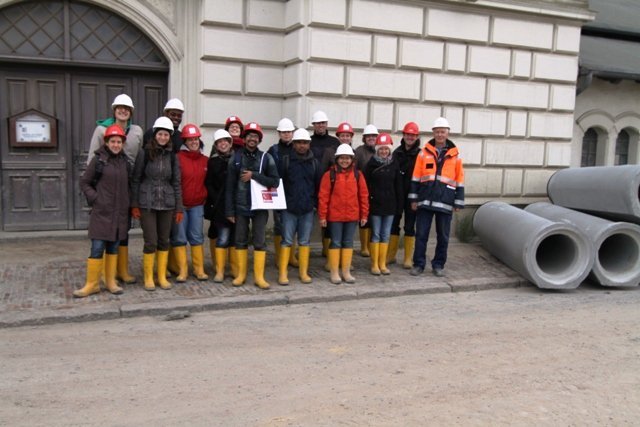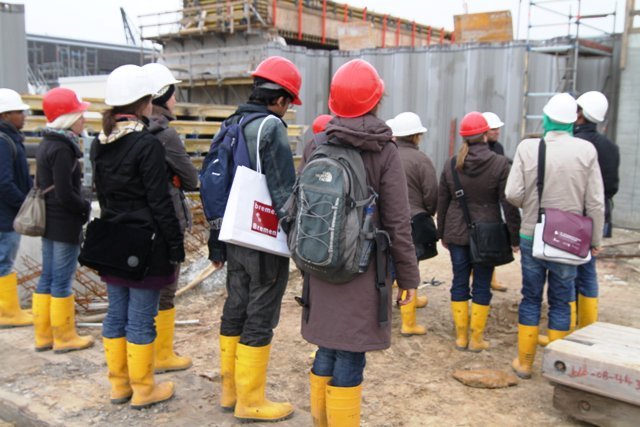Page path:
- INTERCOAST
- Latest News
- Archiv
- News 2010
- INTERCOAST field trip at Bremerhaven
INTERCOAST field trip at Bremerhaven

Bremerhaven and its harbour, at the mouth of the River Weser, are part of the Land of Bremen since 1827 when Johann Smidt, Major of Bremen, bought that piece of land from the King of Hannover, George IV. At that time, indeed, the silting up of the River Weser didn’t ensure a safe navigation up to the old port of Bremen.
Since then, the Bremerhaven harbour has become one of the main seaports of Germany, continuously increasing the import/export trade and upgrading the port structures and facilities.
Since then, the Bremerhaven harbour has become one of the main seaports of Germany, continuously increasing the import/export trade and upgrading the port structures and facilities.
Its development involved coastal, environmental and socio-economical changes: since the beginning, indeed, the construction of wide container areas was realized by means of intense land reclamations, while a regular dredging activity has been executed for navigation maintenance.
During the XIX and XX centuries, the Bremen/Bremerhaven port was witness of millions of people leaving Europe toward Americas. Besides, it has been the location for some of the most important import/export companies, employing (directly and indirectly) thousands of people. In 2007 land reclamation for a new terminal container was undertaken, at the same time with the construction of the new Kaiserschleuse sea lock, able to host cargo vessels with a length/width up to 250/50 m.
The same Bremenport Company which has run the Bremen/Bremerhaven port group since 2002, is now involved in the Jade-Weser Port project to create a deep sea container terminal in Wilhelmshaven, whose impact is currently being studied in some of the INTERCOAST PhD projects. Thus, the recent history of this harbour and its ongoing development represent a good training for understanding such a complex system.
On October 1st, a field trip was arranged for the INTERCOAST project members. The excursion was organized by Sarah J. Farley and leaded by Prof. Dr. Tobias Mörz. Seventeen participants attended a historical and technical introduction to the port area and to the ongoing projects. The lecture was carried out in the “Altes Kraftwerk” (the old power plant), now used as conference room.
During the XIX and XX centuries, the Bremen/Bremerhaven port was witness of millions of people leaving Europe toward Americas. Besides, it has been the location for some of the most important import/export companies, employing (directly and indirectly) thousands of people. In 2007 land reclamation for a new terminal container was undertaken, at the same time with the construction of the new Kaiserschleuse sea lock, able to host cargo vessels with a length/width up to 250/50 m.
The same Bremenport Company which has run the Bremen/Bremerhaven port group since 2002, is now involved in the Jade-Weser Port project to create a deep sea container terminal in Wilhelmshaven, whose impact is currently being studied in some of the INTERCOAST PhD projects. Thus, the recent history of this harbour and its ongoing development represent a good training for understanding such a complex system.
On October 1st, a field trip was arranged for the INTERCOAST project members. The excursion was organized by Sarah J. Farley and leaded by Prof. Dr. Tobias Mörz. Seventeen participants attended a historical and technical introduction to the port area and to the ongoing projects. The lecture was carried out in the “Altes Kraftwerk” (the old power plant), now used as conference room.
After receiving safety boots and helmets, the group could visit the Keiserschleuse building yard: the new structure is replacing the old lock, built in 1897 and still working – with the original wooden piles – till the beginning of 2007. The new system is based on a sliding technology and will allow the use of the lock independently from the tide conditions.
Geotechnical problems related to the presence of clay formation in the harbour area have been discussed. After a typical fish meal in a local tavern, the INTERCOAST trip kept up with a guided sightseeing in the container area.
Geotechnical problems related to the presence of clay formation in the harbour area have been discussed. After a typical fish meal in a local tavern, the INTERCOAST trip kept up with a guided sightseeing in the container area.



